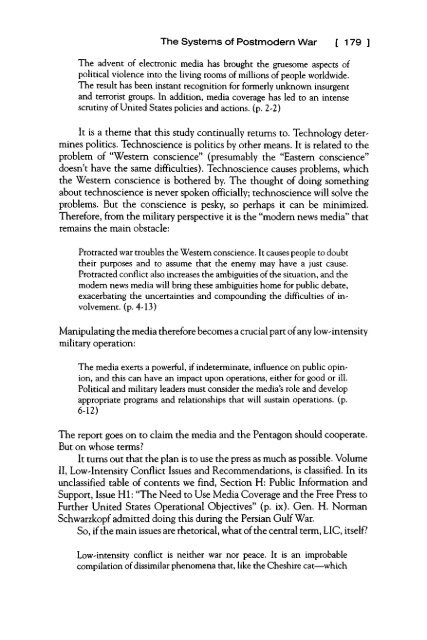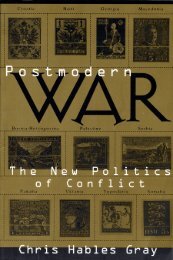9. The Systems of Postmodern War - Chris Hables Gray
9. The Systems of Postmodern War - Chris Hables Gray
9. The Systems of Postmodern War - Chris Hables Gray
You also want an ePaper? Increase the reach of your titles
YUMPU automatically turns print PDFs into web optimized ePapers that Google loves.
<strong>The</strong> <strong>Systems</strong> <strong>of</strong> <strong>Postmodern</strong> <strong>War</strong> [ 179 ]<br />
<strong>The</strong> advent <strong>of</strong> electronic media has brought the gruesome aspects <strong>of</strong><br />
political violence into the living rooms <strong>of</strong> millions <strong>of</strong> people worldwide.<br />
<strong>The</strong> result has been instant recognition for formerly unknown insurgent<br />
and terrorist groups. In addition, media coverage has led to an intense<br />
scrutiny <strong>of</strong> United States policies and actions, (p. 2-2)<br />
It is a theme that this study continually returns to. Technology determines<br />
politics. Technoscience is politics by other means. It is related to the<br />
problem <strong>of</strong> "Western conscience" (presumably the "Eastern conscience"<br />
doesn't have the same difficulties). Technoscience causes problems, which<br />
the Western conscience is bothered by. <strong>The</strong> thought <strong>of</strong> doing something<br />
about technoscience is never spoken <strong>of</strong>ficially; technoscience will solve the<br />
problems. But the conscience is pesky, so perhaps it can be minimized.<br />
<strong>The</strong>refore, from the military perspective it is the "modern news media" that<br />
remains the main obstacle:<br />
Protracted war troubles the Western conscience. It causes people to doubt<br />
their purposes and to assume that the enemy may have a just cause.<br />
Protracted conflict also increases the ambiguities <strong>of</strong> the situation, and the<br />
modern news media will bring these ambiguities home for public debate,<br />
exacerbating the uncertainties and compounding the difficulties <strong>of</strong> involvement,<br />
(p. 4-13)<br />
Manipulating the media therefore becomes a crucial part <strong>of</strong> any low-intensity<br />
military operation:<br />
<strong>The</strong> media exerts a powerful, if indeterminate, influence on public opinion,<br />
and this can have an impact upon operations, either for good or ill.<br />
Political and military leaders must consider the media's role and develop<br />
appropriate programs and relationships that will sustain operations, (p.<br />
6-12)<br />
<strong>The</strong> report goes on to claim the media and the Pentagon should cooperate.<br />
But on whose terms?<br />
It turns out that the plan is to use the press as much as possible. Volume<br />
II, Low-Intensity Conflict Issues and Recommendations, is classified. In its<br />
unclassified table <strong>of</strong> contents we find, Section H: Public Information and<br />
Support, Issue HI: "<strong>The</strong> Need to Use Media Coverage and the Free Press to<br />
Further United States Operational Objectives" (p. ix). Gen. H. Norman<br />
Schwarzkopf admitted doing this during the Persian Gulf <strong>War</strong>.<br />
So, if the main issues are rhetorical, what <strong>of</strong> the central term, LIC, itself?<br />
Low-intensity conflict is neither war nor peace. It is an improbable<br />
compilation <strong>of</strong> dissimilar phenomena that, like the Cheshire cat—which








